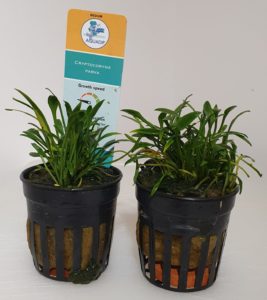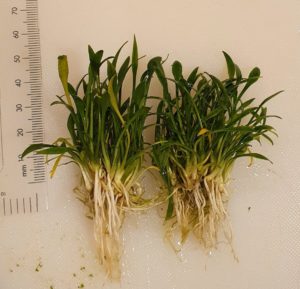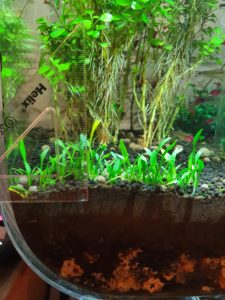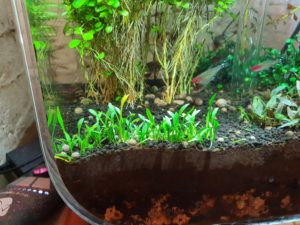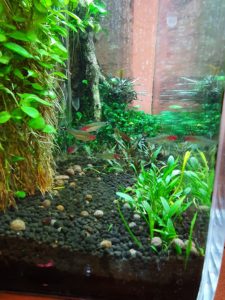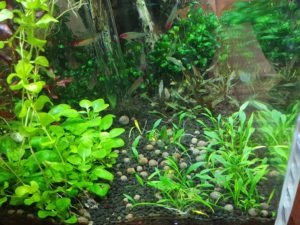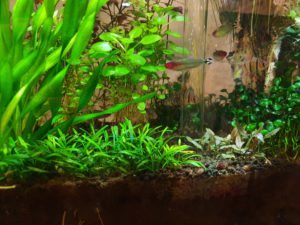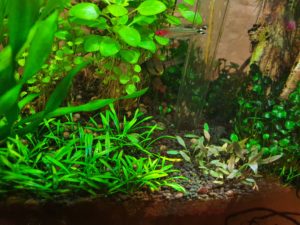I picked up two pots of Cryptocoryne parva from Pro Shrimp as produced by Aquadip with the idea of putting in a crypt a little larger than the Cryptocoryne lutea ‘Hobbit’ in front of the Ludwigia palustris ‘Dwarf’.
The pots arrived promply and in excellent condition. It was straightforward to remove the rockwool growth support using pinsettes, and I was then able to tease apart the two substantial plant masses into many smaller plantlets for individual planting.
My first thought was to plant the parva amongst the pre-existing Marsilea hirsuta and C. lutea ‘Hobbit’, but that rapidly proved impractical so instead I removed a substantial portion of the marsiliea which really was growing a little rampantly out of control, and I transplanted the ‘Hobbit’ to the front-centre of the aquarium to clear the ground for the parva.
The parva planted easily in the cleared ground and made a neat row right across the front of the aquarium. There’s still a lot of cleared space behind the parva which I’ll leave open for now.
One week update
Well… “I’ll leave it open for now” didn’t last very long as a concept. I picked up three more pots of parva, and because Pro Shimp was sold out (I got the last two pots), this time the parva was grown by AquaFleur and sold locally by Aqua Essentials. I thought these new parva pots weren’t quite as nice as the first two: a little smaller and showing some touches of raggedness, but still good. The new parva plantlets filled in some of the thin patches in the front row and let me extend the planting back into the empty space behind. Whilst that was happening, I removed all the leggy Lobelia cardinalis ‘Dwarf’ and replanted the tops to fresh things up, which will also mean more light for the parva. The new parva looks smaller in the aquarium because it was a little smaller, but also because I made an effort to plant it a little more deeply than the parva in front. AquaDip claims a maximum height of 10 cm for the parva, whilst AquaFleur says 5 cm. We’ll see how that shakes out in time.
Cryptocoryne parva vs. Cryptocoryne lutea ‘Hobbit’

For a long time, C. parva was the smallest available cryptocoryne but that changed in recent years with the introduction of C. lutea ‘Hobbit’ to the trade. Here’s a comparison of the new C. parva emersed form plantlets with C. lutea ‘Hobbit’ plants that have been growing in the fully adapted submersed-form for at least three months.
The adapted ‘Hobbit’ is a dark brown/purple colour which is a strong contrast with the bright green colour of the emersed-form ‘Hobbit’. The new parva is a similar bright green, but I expect the parva to stay roughly this same shade of green. The maximum height of parva is listed as 10 cm, whilst the ‘Hobbit’ is listed as growing to 5 cm and indeed the new parva is already as tall as the ‘Hobbit’. The eventual side-to-side comparison of the two will be interesting so hopefully the ‘Hobbit’ will emerge from its transplanting relatively untraumatised.
20 week C. parva vs. C. lutea ‘Hobbit’ update
After 20 weeks the parva has filled in nicely, but hasn’t gotten any taller – the leaves curve over so even at a length of 5 cm the height of the parva tops out at 3 cm. The ‘Hobbit’ lists as being smaller than the parva and whilst this is true in terms of leaf length, the Hobbit leaves stand up straighter and also have an overall height of at most 3 cm. Cryptocoryne parva has thin green narrow leaves – the emersed and submersed forms of parva look nearly identical – whilst the Hobbit has a wider bladed-shaped leaf in dark olive-brown. These are both pretty great small crypts; personal preference might be the decider here rather than height and of course, you can have both!
